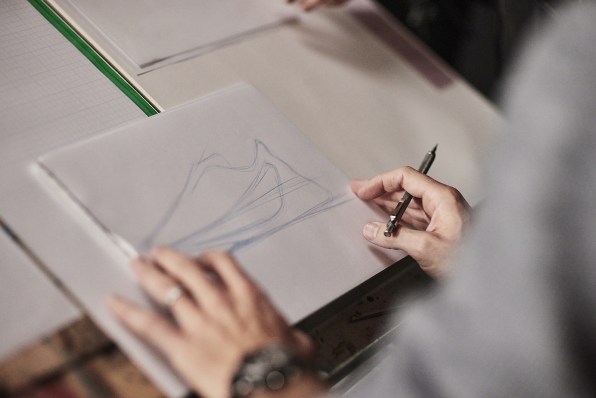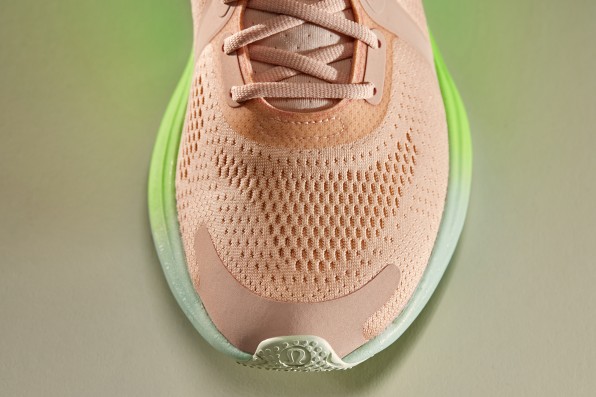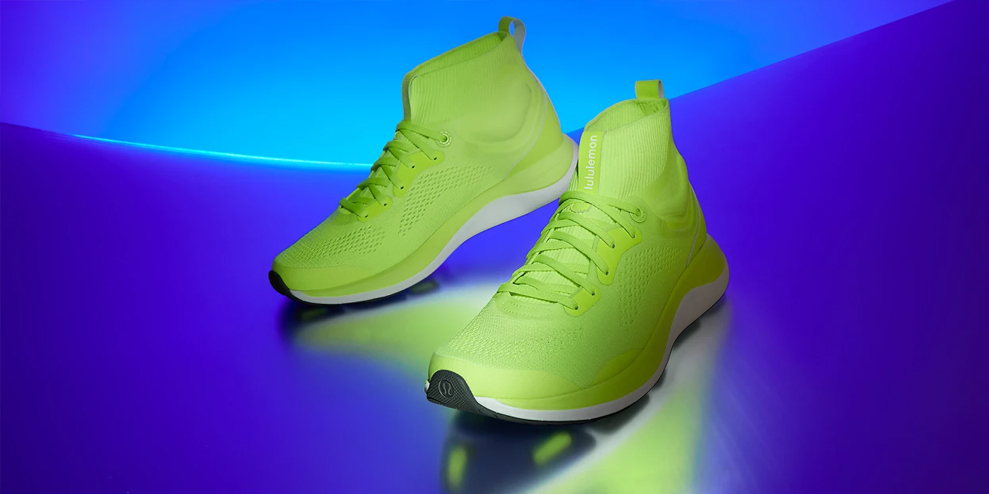The clothing company discovered that women’s breasts influence their entire bodies in motion. Lululemon used this insight to design shoes adapted to women’s bodies.
In its Vancouver lab, Lululemon tracks women’s breast motion and centers of gravity as they run, jump, and stretch to create perfectly fitting sports bras. But four years ago, the brand’s designers realized that this trove of data could help them create an entirely new product: Footwear tailored to the way women’s bodies move.
This March, the brand debuted its first-ever shoe, made for running, and it just launched its second, for cross-training. Both were designed specifically for women. This sets Lululemon apart from most sneaker brands, which often design shoes for male bodies before shrinking them down into women’s sizes.
The brand believes that its women-oriented design strategy will allow it to create athletic shoes that are more supportive, comfortable, and better-performing than others on the market. And given that each round of shoes sold out in most colors within days of launching, the approach seems to be working.

THE ORIGINAL SNEAKER WAS A MEN’S SHOE
In the 1830s, a British entrepreneur named John Boyd Dunlop invented a new shoe that bonded canvas to rubber soles, which was more flexible than leather shoes of the past, creating special shoes for tennis legend Fred Perry. Then, in 1917, Boston-based Converse came out with a shoe specifically designed for basketball, partnering with Chuck Taylor to create a shoe that would help him perform better in the court.ADVERTISEMENT
In the ’50s and ’60s, a wave of sneaker brands popped up, including Puma, Adidas, Reebok, and Nike. They evolved the sneaker with the help of new materials, like synthetic foams for cushioning; but like their predecessors, they were tailored to male athletes’ feet and movements. When they began creating women’s shoes, most simply produced them in smaller sizes and more feminine colors, a strategy that sometimes continues today. “Women’s products are just taken from men’s, shrunken down and with some pink or some glitter slapped onto it,” Libby DeLana, cofounder and creative director of Mechanica, a creative agency that has worked with sneaker brands like Saucony told Glossy in 2019.
Over the years, there have been efforts to adapt shoes to women’s needs. In 2016, for instance, Adidas began using motion-tracking technology to study women’s movement, eventually launching the Pure Boost sneaker with a higher arch; Puma and Under Armour have only just started making running shoes specifically for women. Last year, track star Allyson Felix launched her own brand, Saysh, that makes fashion sneakers tailored to women’s feet. And a new startup, Hilma, is currently designing a performance sneaker for women, which are set to launch shortly.

FROM BRAS TO SHOES
Lululemon believed it was perfectly poised to tackle this market. When it launched in 1998, it was distinct from other sportswear brands because it exclusively made women’s products. (It only began creating menswear in 2014.) The brand debuted with yoga wear but quickly expanded into high-impact sports. Like its competitors, it built a high-tech lab to gather user data. “We do so much women-specific R&D, particularly in relation to bras and how women feel in them,” says Chantelle Murnaghan, Lululemon’s VP of research. “We are constantly looking at how we can extend those sensory experiences from head to toe. But we were always missing the toe component.”
Four years ago, Lululemon decided to start creating shoes. Under the leadership of chief product officer Sun Choe, the company hired a team of experts, including George Robusti, the former senior design director for running at Adidas who now leads Lululemon’s footwear design. And rather than simply take existing sneaker prototypes, the team started with a clean slate. “Typically, the industry has simply aggregated insights and innovations from the past to create new shoes,” says Robusti. “They overlooked the opportunity to design specifically for women. We chose to start from scratch.”
From decades of analyzing women’s bodies in motion—then comparing them to men’s bodies for the launch of menswear in 2014—it was clear to Lululemon’s researchers that women’s feet are distinct from men’s. “A lot of our insights came from doing so much research about breast motion,” says Murnaghan. “We understand every detail of how women’s breasts move, which has allowed us to better understand their full body in motion. It’s clear that shoes can influence how the breasts move, influencing the full trajectory of the body.”
The team began by studying the form of the women’s feet by performing 3D scans. They also worked with bio-mechanists, neuroscientists, and engineers to explore how the morphology of women’s feet relates to the rest of their body. Using in-house data, along with more than a million images from a Swedish 3D scanning company Volumental, they identified that, on average, women have narrower feet. And compared to men, their heels are proportionally narrower than the front part of their foot. Women also can have higher arches. “All of those millimeters in difference make a huge difference,” Robusti says. “It’s the secret sauce to ensuring an elevated fit and feel.”

SO HOW DO THEY FEEL?
After creating some early prototypes, the brand began testing the shoes with hundreds of women, from the brand’s ambassadors to marathoners to everyday consumers. One runner wore it on a foot race from Los Angeles to Las Vegas called The Speed Project. In some feedback rounds, they would send unmarked versions of their shoe, so they could get objective insights.
The goal was to gather quantitative data, but perhaps more importantly, qualitative insights. This is part of Lululemon’s broader design approach, which it calls the “science of feel” and which is focused on the wearer’s subjective experience when wearing a product. “Our unique point of view is that we’re not just creating a product to perform well in an activity,” Robusti explains. “We’re more interested in how the product translates in terms of sensation and emotion.”
The team kept tweaking the shoe based on feedback, and they knew they were on the right track when runners reported that their sneakers were comfortable enough they were able to run for longer periods without feeling fatigue. “We got into a rhythm of quickly prototyping the shoe’s architecture, tuning the foam compounds along the way,” he says. “We joked that what we were testing for was the level of smile at the end of the run.”
In March, Lululemon launched the Blissfeel running shoe; and in August, it dropped the Chargefeel workout shoe. Both sold out across many colors within days, and the brand had to quickly restock. Now, Lululemon is continuing to do R&D to create shoes for other activities. Eventually, it may also begin making men’s shoes. But Lululemon’s successful foray into footwear suggests that there’s a lot of demand for performance-sports shoes specifically designed for women—paving the way for startups like Saysh and Hilma to also enter the market.
For Robusti, the key to the brand’s continued success comes down to constantly studying the complexity of women’s bodies in motion. “We want the shoes to respond to how women’s bodies naturally move, rather than forcing women to modify their movements to their shoes,” he says.
—
This article first appeared in www.fastcompany.com
Seeking to build and grow your brand using the force of consumer insight, strategic foresight, creative disruption and technology prowess? Talk to us at +971 50 6254340 or engage@groupisd.com or visit www.groupisd.com/story

